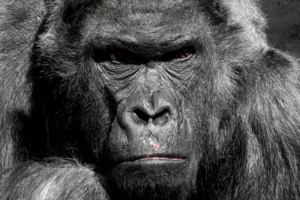There has been considerable speculation about higher primates having similar intellectual and linguistic capabilities to humans.
Some have conjectured that the difference between humans and higher primates is only a matter of degree, but the essential cognitional activity is the same.
If these thinkers are correct, it would mean that higher primates have a tacit awareness of the supreme heuristic notion of being and are, therefore, transcendent in the same way as humans. Is there any way of determining whether this is the case? As a matter of fact, there is.
The critical distinction between perceptual ideas (picture images of individuals) and conceptional ideas (relational ideas that can abstract from individuality and space-time particularity) dovetails felicitously with a behavioral test developed by the well-known philosopher of language, Noam Chomsky.
This test can be applied to the socio-linguistic behavior of higher primates. A quick explanation of this reveals that human beings are categorically different from primates, not only in their linguistic capabilities but also in their capacity to formulate conceptual ideas in language, logic, mathematics, natural science, social science, and philosophy. There is nothing in the socio-linguistic behavior of higher primates—even the best-trained ones—that indicates the presence of conceptual ideas, heuristic notions, or a supreme heuristic notion.
Primates appear to be limited to the domain of perceptual ideas – and linguistic signs that refer to those perceptual ideas. We shall now consider each of these points in more depth.

Perceptual & Conceptual Ideas
With respect to perceptual and conceptual ideas, consider the following. Look at the previous paragraphs in this chapter.
What percentage of the words in those paragraphs have individuated referents—referents that are susceptible to pictorial imaging?
I would wager they are less than three percent. So what are the referents for the other ninety-seven percent of our words? They refer to relationships—relationships among pictorial images, relationships among relationships, and the ways in which things and ideas are related. Perceptual ideas are pictorial images—individuated images coming from direct experience or images derived from direct experience.
In contrast, conceptual ideas have relational referents—which are not derived from direct experience but from relating direct experiences and other conceptual ideas to one another.
Throughout our educational process, we learn how to complexify these relationships between things and ideas. First, we relate perceptual ideas to one another—ideas that have pictorial referents – such as “cat,” “tree,” or “man.”
Then, we relate conceptual ideas to one another (such as “noun,” “verb,” “too,” and “add”). We can move to higher levels of abstraction—relationships among relationships among relationships, etc. This can be done in the domain of grammar, logic, mathematics, the natural sciences, etc.
A Context/Superstructure
How do we create these relationships between perceptual and conceptual ideas?
There must be some context through which to organize them—something like a map or a clock or a table of genus and species—which could provide a background or superstructure through which ideas can be related in an organized way.
Each of these superstructures has high-level ideas intrinsic to them, which determine the way in which ideas are organized—for example,
- “here-there-right – left-center” stands behind the question “Where?”
- “Earlier-later-past-present-future” stands behind the question “When?”
- “Similarity-difference” stands behind the question “What?”
- “Causation-possibility-necessity-contingency-actuality” for the question stand behind the question “Why?”
As implied above, the heuristic notions and high-level concepts standing behind each kind of question derive their meaning from the supreme heuristic notion of “the complete intelligibility of reality.” Why? The supreme heuristic notion of complete intelligibility is what enables us to see the deficiencies and imperfections in our current knowledge, causing us to inquire about the next step beyond it.
Recall that this supreme heuristic notion is the “tacit awareness of everything to be known”—and the notional anticipation of achieving it. When we contrast this universal anticipation with our current knowledge—we become aware that there are blanks to be filled in —and we desire and seek to do so.
This universal anticipation stands behind every question, and every question stands behind the heuristic notions and high level conceptual ideas used to relate all other ideas and images to one another.
Do higher primates form conceptual ideas?
We are now in a position to make a judgment about animal intelligence (specifically the intelligence of higher primates). Do higher primates form conceptual ideas? Do they transform perceptual ideas into conceptual ideas through interrelationships within superstructures organized by heuristic notions?
Noam Chomsky gave the first linguistic test to answer these questions and on the basis of it, held fast to the belief that they do not. Chomsky realized that certain words in a sentence could have direct pictorial referents but was certain that the syntax of a sentence could not be grasped pictorially. It can only be grasped by understanding relationships among ideas.
A simple test of this would be to grasp the meaning of subject and object in the word order of a sentence—for example, “dog bites man” versus “man bites dog.” Even though one could grasp “dog,” “bites,” and “man” through perceptual ideas, one cannot grasp the difference between subject and object in a sentence’s word order without some conceptual (relational) ideas.
Do higher primates grasp the syntactical difference between subject and object as small children do, who laugh at the curious thought of a man biting a dog? Contemporary research indicates that they do not.
There is considerable evidence that vertebrates generate perceptual ideas, manifesting perceptual intelligence. For example, animals can relate perceptual images, such as a rabbit and a tree, to one another spatially (and to themselves). Notice that what the animal perceives is an individual object or image – it is a picture in the animal’s consciousness.
So, does the animal go beyond relating perceptual ideas in space and time? Do they implicitly understand the most rudimentary implications of grammar communicated by word order? If they do not, then we can be sure that they do not grasp elementary conceptual (relational) ideas – and that they are restricted to the domain of perceptual ones.
Perceptual Intelligence & Elementary Language
Is perceptual intelligence sufficient for elementary language? Researchers have shown that it is. For example, primates have the ability to associate signs (such as those from American Sign Language) with their perceptual (picture) thoughts.
However, these associations appear to have no other purpose than to name or identify specific things (such as Joe the trainer, or a banana, or a perceptual action like running or biting) to satisfy biological opportunities (such as obtaining food or shelter) or to communicate biological dangers (such as the approach of a predator).
For example, a chimpanzee can be taught to use sign language to communicate a need for food or even a warning about danger but cannot be trained to use language to say something about something (which would require syntactical control—the intelligible use of predicates and objects).
One of the more controlled experiments in this regard was carried out by Allen and Beatrix Gardner in 1967 (Project Washoe), in which a female chimpanzee named Washoe was raised in a very familial human environment with affection and other human bonding qualities.


